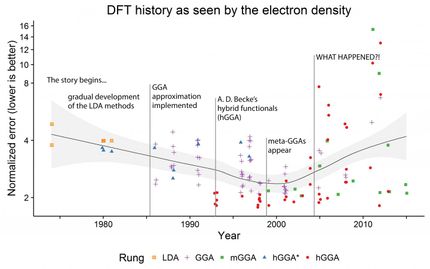In search of a greener cleaner
Molecular chelating agents are used in many areas ranging from laundry detergents to paper pulp processing to precious metal refining. However, some chelating agents, especially the most effective ones, do not degrade in nature and may pollute the environment. With support from the National Science Foundation (NSF), researchers at the University of Pittsburgh Swanson School of Engineering are developing machine learning procedures to discover new chelating agents that are both effective and degradable.
Dr. John Keith, a Richard King Mellon Faculty Fellow in Energy and assistant professor of chemical engineering at Pitt, is principal investigator; and Dr. Eric Beckman, Distinguished Service Professor of chemical engineering and co-director of Pitt's Mascaro Center for Sustainable Innovation, is co-PI. Their project titled "SusChEM: Machine learning blueprints for greener chelants" will receive $299,999 from the NSF.
"Chelating agents are molecules that bind to and isolate metal ions dissolved in water," explains Dr. Keith. "Cleaning detergents normally don't work well in hard water because of metal ions like magnesium and calcium interfering. That's why commercial detergents typically include some chelating agents to hold up those metal ions so the rest of the detergent can focus on cleaning."
While chelating agents are valued for their ability to bind strongly to different metal ions, researchers are also factoring how long it takes them to degrade in the environment and their probabilities of being toxic when searching for more effective chelate structures. "Many of the widely used chelating agents we use end up in water runoffs, where they can be somewhat toxic to wildlife and sometimes to people as well," says Dr. Beckman.
Developing new chelating agents so far has relied on trial and error experimentation. Dr. Beckman continues, "In the past, folks have tried to create better chelating agents by tweaking existing structures, but whenever that produces something less toxic, the chelating agent winds up being much less effective too. We're trying a new approach that uses machine learning to look through much larger and more diverse pools of candidate molecules to find those that would be the most useful."
The Pitt research team will use quantum chemistry calculations to develop machine learning methods that can predict new molecules that would be more effective and greener than existing chelating agents. While computational quantum chemistry can be used to screen through a thousand hypothetical chelating agents in a year, machine learning methods based on quantum chemistry could be used to screen through 100,000s of candidates per week. Once the researchers identify promising candidates, they will synthesize and test them in their labs to validate the efficacy of the machine learning process for designing greener chemicals.
The results of the research will have a significant impact on a range of topics relevant to environmentally-safe engineering and the control of metals in the environment, including computer-aided design of greener chelating agents used in detergents, treatments of heavy metal poisoning, metal extractions for soil treatments, waste remediation, handling normally occurring radioactive materials from hydraulic fracturing sites, and water purification.
"Chelating agents are used in such a wide range of industries, so even a small improvement can have a big impact on sustainability as a whole," says Dr. Keith.
Most read news
Topics
Organizations
Other news from the department science

Get the chemical industry in your inbox
By submitting this form you agree that LUMITOS AG will send you the newsletter(s) selected above by email. Your data will not be passed on to third parties. Your data will be stored and processed in accordance with our data protection regulations. LUMITOS may contact you by email for the purpose of advertising or market and opinion surveys. You can revoke your consent at any time without giving reasons to LUMITOS AG, Ernst-Augustin-Str. 2, 12489 Berlin, Germany or by e-mail at revoke@lumitos.com with effect for the future. In addition, each email contains a link to unsubscribe from the corresponding newsletter.



























































